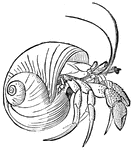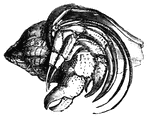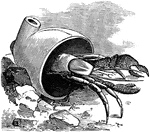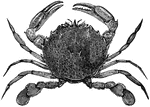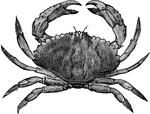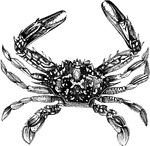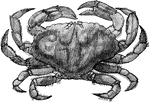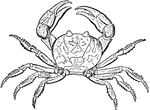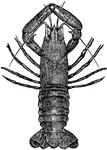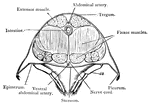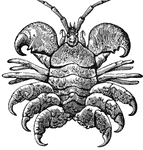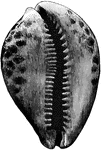The Crustaceans ClipArt gallery features 224 illustrations of crustacean species, such as crabs, lobsters, crayfish, and shrimp.
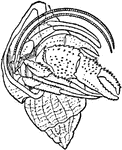
Hermit Crab
Pagurus bernhardus is the common marine hermit crab of Europe's Atlantic coasts. It is sometimes referred…
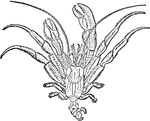
Hermit Crab
Hermit crabs are decapod crustaceans of the superfamily Paguroidea. They are not closely related to…

King crab
"It is among the largest of crustaceous animals, sometimes measuring as much as two feet in length.…

Land Crab
The land crab is a member of the family 'Gecarcinidae', and is remarkable for the curious modification…

Masked Crab
Corystes cassivelaunus, the masked crab, helmet crab or sand crab, is a burrowing crab of the North…
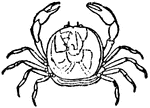
Pea Crab
The pea crab is a small crab in the family Pinnotheridae that lives symbiotically in oysters, clams,…

Scorpion Spider Crab
Inachus dorsettensis. "A spider-like crab, or sea-spider, with long slender legs and comparatively small…

Shore Crab
"Dorsal aspect of shore crab (Carcinnus). Abd., Abdomen; A1., antennules; A2., antennae; E., eyes; F.,…
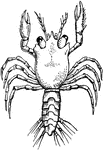
Shore Crab
Carcinus maenas is a common littoral crab, and an important invasive species. It is listed among the…
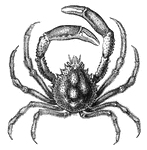
Spider-Crab
Crabs are ten-footed crustaceans. The abdomen is tucked out of site, so that nothing is visible except…
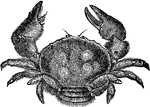
Sponge Crab
A crab that usually hides in sponges on the ocean floor. It apears soft because of the algae that grows…
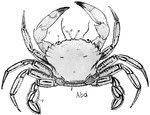
Swimming Crab
"Dorsal aspect of swimming crab (Portunus). P., Paddle; Abd., abdomen; A1., antennules; A2., antennae;…

Velvet Crab
The velvet crab (alternatively velvet swimming crab or devil crab) is the largest swimming crab found…
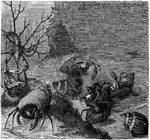
Hermit Crabs
An illustration of hermit craps shedding their shells and finding new ones. As hermit crabs grow they…
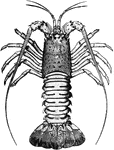
Crawfish
"Also known as Florida lobster. This Southern species, a "spiny" lobster, found off the southern Florida…

Crawfish
"Crawfish, or Crayfish is a name of various crustaceous animals, the common crawfish being the river…

Crawfish
Crayfish, crawfish, or crawdads are freshwater crustaceans resembling small lobsters, to which they…
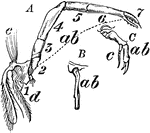
Crawfish Leg
"A, Developed Endopodite, or ordinary ambulatory leg of the crawfish as a thoracic appendage: ab, the…
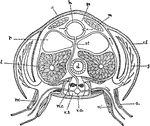
Cray-fish
"Diagrammatic cross-section of Cray-fish in the thoracic region, to show relation of circulation and…
Crayfish
Longitudinal-section of a crayfish, showing digestive, circulatory, reproductive, excretory, and nervous…

Crayfish
Crayfish, crawfish, or crawdads are freshwater crustaceans resembling small lobsters, to which they…

Crustacea
Types of the Lower Crustacea. 1, Balanus; 2, Cytherea lutea; 3, Dapania pulex; 4, Lepus anatifera; 5,…
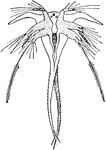
Barnacles
A barnacle is a type of arthropod belonging to infraclass Cirripedia in the subphylum Crustacean, and…

Barnacles
A barnacle is a type of arthropod belonging to infraclass Cirripedia in the subphylum Crustacean, and…
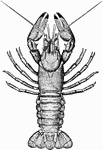
Crayfish
Crayfish, crawfish, or crawdads are freshwater crustaceans resembling small lobsters, to which they…

Crayfish
Crayfish, crawfish, or crawdads are freshwater crustaceans resembling small lobsters, to which they…

Cyclops
Cyclops, the representative of a number of lowly forms belonging to the order of Copepods, is one of…

Fairy-shrimp
The class of crustacea is divided into two sub-classes, Entomostraca and Malacostraca. The first, Entomostraca,…
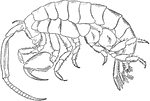
Marine Isopod
The marine isopod or sand flea (Gammarus) is in the sand, under rocks, and in the seaweed. Many are…

Marine Isopod
The marine isopod or sand flea (Caprella) is an omnivorous feeder that eats detritus, one-celled plants,…

Prawn
Prawns are crustaceans, belonging to the sub-order Dendrobranchiata. They are similar in appearance…
Shrimp
The larger, more useful and more familiar Crustacea belong to the subclass Malacostraca. It comprises…

Cyclops
"The best-known form of the Copepoda is the genus Cyclops, specimens of whch may be found in…
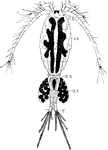
Cyclops
"Cyclops type. I A., first antenna; II A., second antenna; OV., ovary; R.S., receptaculum seminis; OS.,…
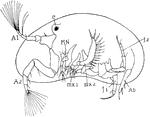
Cypris
"Cypris, side view, after removal of one valve. e., Eye; A.1, first antennae; A.2, second antennae;…

Cypris
Cypris, a modern ostracod. Female before sexual maturity, right valve of shell removed to show internal…
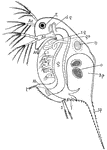
Daphnia
"Daphnia. E., Eye; A.2, second antenna; A.1, first antenna; dg., digestive caeca; s.g., shell gland;…
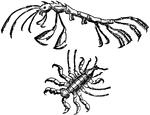
Edriophthalma
"Edriophthalma: 1, Caprella phasma; 2, Cyamus Balaenarius." — Chambers' Encyclopedia, 1875
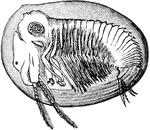
Estheria
Estheria californica is a species of Branchiopod crustaceans most closely resembling the shrimp.
